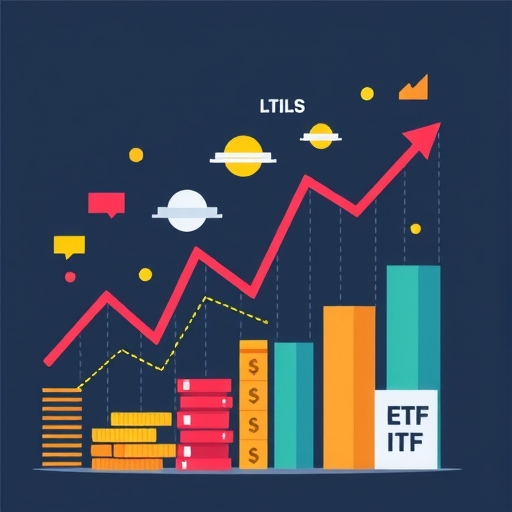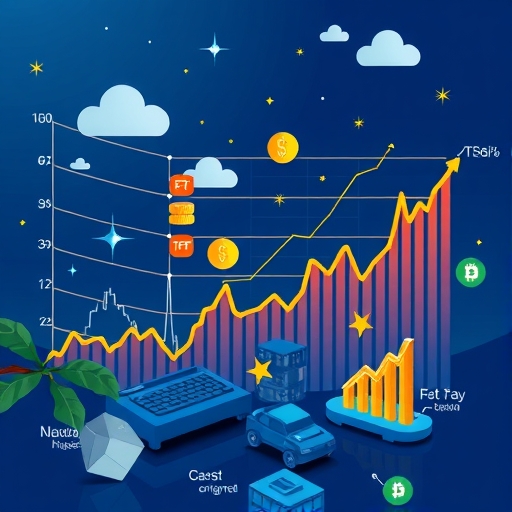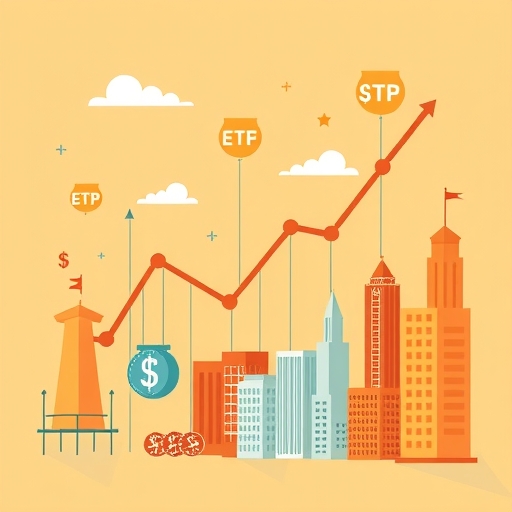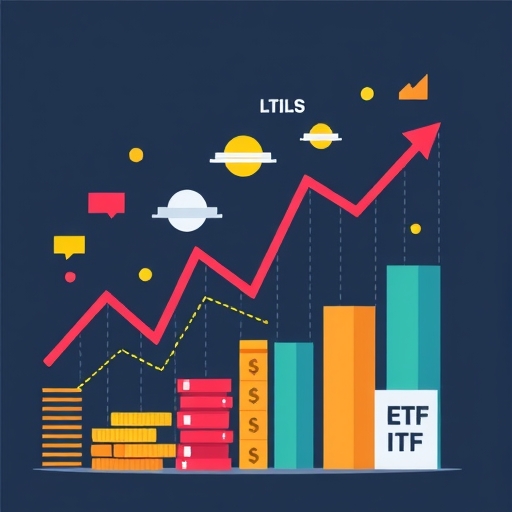Are Exchange-Traded Funds (ETFs) the Right Investment for Your Portfolio?
In today’s dynamic financial landscape, you might have heard a lot about Exchange-Traded Funds (ETFs). They’ve become a cornerstone for many investors, blending the diversification benefits of mutual funds with the trading flexibility of individual stocks. But what exactly are they, and how can they fit into your financial strategy? We’re here to demystify ETFs, exploring their fundamental nature, diverse applications, and crucial considerations for both new and experienced investors looking to optimize their financial strategies.

This comprehensive guide will walk you through the world of ETFs, covering their core mechanics, the compelling advantages they offer, potential drawbacks to be aware of, the vast array of types available, and practical advice on how to integrate them effectively into your investment portfolio. By the end, you’ll have a clear understanding of whether these powerful investment vehicles align with your goals for long-term wealth building.
Before diving deeper, consider these foundational aspects of ETFs:
- They offer broad diversification across various asset classes or market segments.
- They provide trading flexibility, allowing buying and selling throughout the market day.
- They are generally known for their cost-efficiency compared to many traditional investment vehicles.
What Exactly are Exchange-Traded Funds (ETFs)?
At its core, an Exchange-Traded Fund (ETF) is a type of investment fund that holds a collection of assets—like stocks, bonds, or commodities—but trades on a stock exchange just like a regular stock. Think of it as a basket filled with various investments. When you buy a share of an ETF, you’re buying a small piece of that entire basket, giving you exposure to all the assets inside with a single transaction.
Key characteristics of ETFs often include:
- Intraday trading capability on stock exchanges.
- Lower expense ratios, especially for passively managed funds.
- High transparency regarding their underlying holdings.

Unlike mutual funds, which are priced only once per day after the market closes, ETFs can be bought and sold throughout the trading day at market prices that fluctuate based on supply and demand. This real-time pricing and intraday trading flexibility are key features that distinguish ETFs. How is this possible? ETF providers own the underlying assets and design their funds to track the performance of a specific index, sector, or commodity. They then sell shares of this fund to investors.
A crucial mechanism that helps keep an ETF’s market price aligned with the value of its underlying assets, known as its Net Asset Value (NAV), is the creation and redemption process. This process involves large institutional investors called Authorized Participants (APs). When an ETF’s market price deviates significantly from its NAV, APs can create new ETF shares by delivering a basket of the underlying assets to the ETF provider, or redeem existing ETF shares by receiving a basket of underlying assets from the provider. This arbitrage mechanism ensures that the ETF’s market price generally stays close to its NAV, maintaining market efficiency. This unique structure also contributes to one of the ETF’s most appealing benefits: its tax efficiency.
To further illustrate the fundamental characteristics of ETFs, here is a summary:
| Characteristic | Description |
|---|---|
| Market Trading | Traded on stock exchanges like individual stocks throughout the day. |
| Diversification | Offers exposure to multiple assets (stocks, bonds, commodities) in a single fund. |
| Pricing | Market price fluctuates based on supply and demand, distinct from NAV. |
| Transparency | Holdings are typically disclosed daily, providing clear insight. |
| Cost-Efficiency | Often features lower expense ratios due to passive management. |
The Power of ETFs: Key Advantages for Investors
ETFs have seen remarkable growth, quadrupling in assets under management since 2015, far exceeding mutual fund growth over the same period. Why are they so popular? ETFs offer a compelling blend of benefits that can enhance almost any investment portfolio. Let’s explore some of the most significant advantages:

- Diversification: This is arguably one of the biggest appeals. An ETF allows you to achieve broad exposure to various assets, sectors, or markets through a single investment. Instead of buying individual stocks, you can buy an ETF that holds hundreds of stocks, instantly diversifying your portfolio and reducing the risk tied to any single company. For example, a broad market ETF tracking the S&P 500 automatically gives you a piece of 500 large U.S. companies.
- Cost-Efficiency: Generally, ETFs feature lower expense ratios (annual fees) compared to actively managed mutual funds. This is because many ETFs are passively managed, simply tracking an index rather than paying a team of managers to pick individual stocks. Over time, these lower fees can significantly boost your net returns.
- Tax Benefits: ETFs are often more tax-efficient than traditional mutual funds due to their creation and redemption mechanism. The way they handle capital gains distributions to shareholders is unique; capital gains taxes are typically incurred only when you sell your ETF shares, not when the fund itself sells underlying assets to rebalance. This can defer taxes and potentially improve your after-tax returns.
- Transparency: With ETFs, you always know what you own. Their holdings and price activity are disclosed daily and are easily accessible to the public. In contrast, mutual funds often report their holdings less frequently, typically monthly or quarterly, giving you less real-time insight into their portfolios.
- Liquidity & Flexibility: Just like individual stocks, ETFs can be bought and sold throughout the trading day. This intraday trading flexibility allows you to react quickly to market changes, enter or exit positions, and even use advanced trading strategies. This is a significant advantage over mutual funds, which can only be traded once daily at their end-of-day NAV.
- Accessibility: ETFs often have lower minimum investment requirements, making them accessible to a wider range of investors, including those just starting out. Many online brokers even offer commission-free trading for a wide selection of ETFs, further reducing the cost of entry.
The numerous advantages of ETFs make them a versatile tool for various investment strategies:
| Advantage | Benefit for Investors |
|---|---|
| Broad Diversification | Reduces risk by spreading investments across many securities or sectors. |
| Lower Costs | Minimizes fees, potentially leading to higher net returns over time. |
| Tax Efficiency | Can defer capital gains taxes until shares are sold, enhancing after-tax returns. |
| Transparency | Provides clear visibility into fund holdings daily, aiding informed decisions. |
| Liquidity | Allows for real-time buying and selling, offering trading flexibility. |
Navigating the Risks: Potential Drawbacks of ETF Investing
While ETFs offer numerous advantages, it’s crucial to approach any investment with a balanced perspective. Like all financial products, they come with their own set of potential drawbacks and risks that you should understand before investing. What are some of these considerations?
- Trading Costs: Although many brokers now offer commission-free ETF trading, you might still incur a bid-ask spread. This is the difference between the highest price a buyer is willing to pay (bid) and the lowest price a seller is willing to accept (ask). For less frequently traded or niche ETFs, this spread can be wider, effectively increasing the cost of buying and selling.
- Liquidity Issues: While broad market ETFs are generally very liquid, niche or low-volume ETFs can be harder to buy or sell quickly without impacting the price. If an ETF doesn’t trade much, you might face wider bid-ask spreads and less favorable prices when you need to execute a trade.
- Risk of Fund Closure: ETFs, especially newer or less popular ones with insufficient assets under management, can sometimes close down. If your fund closes, you’ll be forced to sell your shares, potentially at an inconvenient time or even a loss, and then find a new place for your investment.
- Tracking Error: Passively managed ETFs aim to perfectly replicate the performance of their underlying index. However, due to factors like management fees, trading costs within the fund, and the difficulty of perfectly mirroring an index (especially for complex ones), an ETF’s performance might not perfectly match its benchmark. This difference is known as tracking error.
- Lack of Customization: ETFs are pre-packaged funds. While this offers diversification, it means you have no say in selecting individual assets within the fund. If you have strong convictions about specific companies, you might find ETFs too broad for your precise investment strategy.
- Increased Risk for Specialized ETFs: Not all ETFs are created equal in terms of risk. Specialized ETFs, such as Leveraged ETFs and Inverse ETFs, carry significantly higher risks. Leveraged ETFs aim to amplify daily returns (e.g., 2x or 3x the index’s movement), while Inverse ETFs try to profit from a market decline. These are complex instruments generally suited for experienced, short-term traders and are typically unsuitable for long-term investors due to their daily rebalancing and compounding effects. Similarly, emerging asset-focused funds like Bitcoin ETFs or other Crypto ETFs still carry high asset-class specific risks due to the volatility of cryptocurrencies.
While powerful, it is crucial to be aware of the potential risks associated with ETF investing:
| Potential Drawback | Consideration for Investors |
|---|---|
| Trading Costs | Bid-ask spreads, especially for less liquid ETFs, can add to costs. |
| Tracking Error | Fund performance may not perfectly match its benchmark due to various factors. |
| Fund Closure Risk | Smaller or unpopular ETFs might close, forcing premature liquidation. |
| Specialized ETF Risks | Leveraged, inverse, or crypto ETFs carry significantly higher volatility and complexity. |
| Lack of Customization | Pre-packaged nature means no control over individual asset selection within the fund. |
A World of Choices: Exploring Different Types of ETFs
One of the most exciting aspects of ETFs is the sheer variety available. There’s likely an ETF designed to meet almost any investment goal or to gain exposure to nearly any market segment. Understanding the different types is key to building a diversified and robust investment portfolio. Let’s categorize them to make sense of the vast options:

Asset-Class Focused ETFs
- Equity/Stock ETFs: These are the most common type, investing in a basket of stocks. They can be broad market (e.g., S&P 500, Nasdaq), or focused on specific market capitalizations (large-cap, mid-cap, small-cap).
- Bond/Fixed-Income ETFs: These funds invest in various bonds, such as government bonds, corporate bonds, or municipal bonds. They offer income generation and can be a good option for diversifying away from stocks.
- Commodity ETFs: These provide exposure to raw materials like gold, oil, agriculture products, or precious metals. They can be a hedge against inflation or geopolitical risks.
- Currency ETFs: These aim to track the performance of specific foreign currencies against the U.S. dollar.
- Multi-Asset ETFs: These funds combine different asset classes—like stocks, bonds, and commodities—into a single ETF, offering built-in diversification.
Market/Sector Focused ETFs
- Sector/Industry ETFs: These funds focus on specific industries, such as technology, healthcare, energy, or utilities. They allow you to invest in areas where you have high conviction, but also come with higher volatility than broad market funds.
- Broad Market ETFs: These track major market indices like the S&P 500, Nasdaq, or MSCI World. They offer wide diversification across many companies and are often recommended as a core holding for most investors.
- International/Foreign Market ETFs: These funds allow you to invest in companies located outside your home country, providing geographical diversification and exposure to global economic growth. This offers an easier and often less risky alternative to individual foreign stocks.
Strategy/Risk Focused ETFs
- Index ETFs: The most common type, these are passively managed funds designed to replicate the performance of a specific market index. They are known for their low expense ratios.
- Actively Managed ETFs: Unlike index funds, these have a fund manager who actively selects and trades securities with the goal of outperforming a benchmark. They typically have higher expense ratios.
- Smart Beta/Factor ETFs: These funds track an index that is weighted by factors other than market capitalization, such as value, momentum, low volatility, or dividend yield. They aim to capture specific market “factors” believed to drive returns.
- Dividend ETFs: These focus on companies that consistently pay dividends, appealing to investors seeking income generation.
- Leveraged ETFs: As mentioned, these funds use financial derivatives to amplify the daily returns of an underlying index, often by 2x or 3x. They are highly risky and best suited for very short-term trading.
- Inverse ETFs: Also using derivatives, these funds aim to profit from a decline in an underlying index, often by 1x, 2x, or 3x the inverse of its daily performance. Like leveraged ETFs, they are highly risky and for short-term use only.
- Exchange-Traded Notes (ETNs): It’s important to note that ETNs are debt instruments, not true ETFs. They are unsecured debt obligations issued by a bank and track an underlying index. While they offer similar trading features, they carry credit risk of the issuer, unlike traditional ETFs which own the underlying assets.
Emerging Asset Focused ETFs
- Bitcoin ETFs / Crypto ETFs: These are newer types of ETFs that provide exposure to cryptocurrencies without requiring investors to directly buy and store the digital assets themselves. They can track the price of Bitcoin directly or invest in futures contracts. However, they still carry the high volatility and unique risks associated with the cryptocurrency asset class.
With such a vast selection, how do you choose? The key is to align your choice with your personal financial goals, risk tolerance, and time horizon. Broad-market ETFs, for example, are often recommended for beginners as a portfolio foundation, while sector-specific ETFs can be used strategically for conviction plays.
Strategic Placement: How ETFs Fit into Your Portfolio
Understanding what ETFs are and their various types is only part of the equation. To effectively utilize them, we need to see how they stack up against other popular investment vehicles and how you can integrate them into your personal financial plan. Let’s compare ETFs with their closest relatives: mutual funds and individual stocks.
ETFs vs. Mutual Funds vs. Stocks: A Quick Comparison
While all three can be valuable components of an investment portfolio, they each have distinct characteristics:
| Feature | Exchange-Traded Funds (ETFs) | Mutual Funds | Individual Stocks |
|---|---|---|---|
| Trading | Throughout the day (like stocks) | Once daily (after market close) | Throughout the day (like ETFs) |
| Pricing | Real-time market price | End-of-day Net Asset Value (NAV) | Real-time market price |
| Diversification | High (basket of assets) | High (basket of assets) | Low (single company risk) |
| Fees | Generally lower expense ratios | Often higher expense ratios | Broker commissions (if applicable) |
| Transparency | Daily disclosure of holdings | Monthly/quarterly disclosure | Publicly available company data |
| Tax Efficiency | Generally more tax-efficient | Can have more capital gains distributions | Capital gains on sale, dividends taxed |
| Minimum Investment | Often low (cost of one share) | Can be high ($1,000s) | Cost of one share (or fractional) |
As you can see, ETFs offer a unique blend, combining the diversification of mutual funds with the trading flexibility and real-time pricing of stocks. They provide a buffer against single-company volatility that individual stocks cannot, while often being more cost-effective and transparent than many mutual funds.
Investing in ETFs: Your Step-by-Step Guide
Ready to start exploring ETFs? Here’s a basic roadmap to help you:
To ensure a successful journey with ETFs, keep these core principles in mind:
- Always match your ETF selection to your specific financial goals and risk tolerance.
- Regularly review and rebalance your portfolio to maintain your desired asset allocation.
- Understand the difference between broad-market, sector-specific, and specialized ETFs to choose wisely.
- Open a Brokerage Account: You’ll need an investment account with an online broker. Many popular platforms offer commission-free trading for a wide selection of ETFs.
- Define Your Financial Goals and Risk Tolerance: Before investing, ask yourself: What are you saving for? How long do you plan to invest? How much market volatility can you comfortably handle? Your answers will guide your ETF choices.
- Thorough Research: This is where financial literacy comes in. Research ETFs that align with your goals. Look at their expense ratios, what index or assets they track, their historical performance, and the issuer. Remember Warren Buffett’s famous advice: he advocates for low-cost S&P 500 index funds for long-term wealth building, highlighting their historical gains and lower volatility.
- Buy with a Ticker: Once you’ve chosen an ETF, you’ll use its ticker symbol (e.g., VOO for a Vanguard S&P 500 ETF) to place an order through your brokerage account, just like buying a stock.
- Plan an Exit Strategy: While ETFs are great for long-term investing, it’s wise to have a plan for when you might need to sell. This could be tied to a specific financial goal or a portfolio rebalancing strategy.
Financial advisors play a crucial role here, especially if you’re feeling overwhelmed. They can help demystify ETFs, explain the specific risks (which depend heavily on the underlying assets), and guide you on how to effectively integrate them into your broader financial plan, emphasizing long-term wealth building and risk management. It’s important to understand that not all ETFs are equal in risk; a technology sector ETF will likely behave differently than a bond ETF, and both will have different risk profiles than a highly volatile cryptocurrency ETF.
Conclusion
Exchange-Traded Funds represent a dynamic and accessible tool for investors seeking to build diversified, cost-effective portfolios. They offer numerous advantages in terms of flexibility, transparency, and tax efficiency, making them a cornerstone of modern investing. However, as with any investment, a thorough understanding of their mechanics, various types, and inherent risks is paramount. By embracing financial literacy and strategically integrating ETFs into your financial plan, you can confidently navigate the markets and empower your long-term wealth creation journey.
Disclaimer: This article is for informational and educational purposes only and does not constitute financial advice. Investing in ETFs or any other financial product involves risks, including the potential loss of principal. Always consult with a qualified financial advisor before making any investment decisions.
Frequently Asked Questions (FAQ)
Q: What is the main difference between an ETF and a mutual fund?
A: The primary difference lies in their trading flexibility and pricing. ETFs trade on stock exchanges throughout the day at market prices, similar to individual stocks. Mutual funds, on the other hand, are priced once daily after the market closes based on their Net Asset Value (NAV), and can only be bought or sold at that end-of-day price.
Q: Are ETFs suitable for long-term investors?
A: Yes, many ETFs, particularly broad-market index ETFs, are excellent tools for long-term investors due to their diversification, low expense ratios, and tax efficiency. However, highly specialized ETFs like leveraged or inverse funds are generally not suitable for long-term holding due to their complex structures and daily rebalancing effects.
Q: How do ETFs offer tax benefits?
A: ETFs are often more tax-efficient than traditional mutual funds because of their unique “creation and redemption” mechanism. This process allows institutional investors to exchange ETF shares for underlying securities, which helps the fund avoid realizing and distributing capital gains to shareholders, thereby deferring taxes until the investor sells their ETF shares.



No responses yet